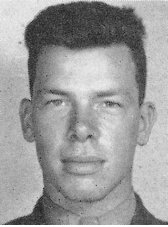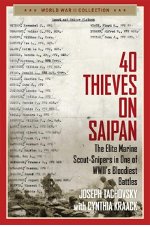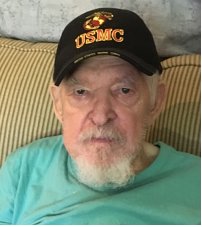Blast from the Past: Corporal Robert Gene Smotts, A Tachovsky Terror & Thief on Saipan
Blast from the Past: Corporal Robert Gene Smotts, A Tachovsky Terror & Thief on Saipan

Having addressed Marine scout snipers and combat veterans from Second Battalion, Fifth Marine Regiment and Second Battalion, Sixth Marines during WWI, we’ll turn next in the Blasts series to feature Marine scout snipers serving in combat during WWII.
Some of you may be aware that the late Academy Award-winning television and screen actor Lee Marvin was a Marine scout sniper who participated in 21 amphibious assaults on Japanese-held islands, including Saipan when he was seriously wounded in action in June 1944 while taking part in Operation Forager.
While PFC Marvin is a well-known WWII Marine warfighter with a short fuse, the Sixth Marine Regiment scout sniper platoon that we all should know included the Silver Star recipient First Lieutenant Frank Tachovsky. Meticulously researched in his book (with the award-winning novelist Cynthia Kraack) Forty Thieves on Saipan: The Elite Scout Snipers in One of WWII’s Bloodiest Battles (Regnery History, 2020), Lt Tachovsky’s son Joe weaves a fascinating story of the 6th Marines scout sniper platoon in combat.

Among the central figures in the story Tachovsky and Kraack tell is Corporal Bobbie Smotts who survived both Operation Galvanic at Tarawa and Operation Forager at Saipan.
Beginnings
Smotts grew up after 1925 on the Osage Nation Reservation in Hominy, Oklahoma, home of an all-Indian professional football team that defeated the then world champion New York Giants in 1927 and where he learned to hunt, trap, and shoot.
A grunt in Alpha Company 1/6 who had survived Tarawa, Smotts volunteered for the 6th Marines scout sniper platoon when it first formed in Hawaii. The note Smotts received notifying him he was selected cryptically stated, “January 18, 1700” and included latitude and longitude coordinates where he and the other selectees were left to assume they were to show up.
From January through May, the 6th Marines combat veterans trained from their home located at Camp Tarawa on Parker Ranch near Waimea, Hawaii. “We was trained better than any other troops in the service on how to kill in every conceivable method,” Smotts would later tell Joe Tachovsky, “ways that you can’t even fathom.” “Stealth,” Tachovsky writes in 40 Thieves, “was paramount.... These Marines had to be just as cunning and deceptive as the Japanese.”
Leaving Parker Ranch
On May 30, 1944, the 6th Marines and its scout sniper platoon left Parker Ranch aboard the USS Bolivar, a Bayfield-class attack transport in service with the U.S. Navy from 1943-46. Listening over loudspeakers on the deck of the USS Bolivar to FDR ask the American people to pray for U.S. troops on D-Day in Europe, Smotts apparently muttered, “There ain’t no God where we’re going.... No amount of prayin’s gonna save me now.”
From Red Beach Two & Three Inland Into Combat on Both Sides of the Japanese Lines
Departing over the sides of a crippled Higgins boat with a non-functioning ramp approaching the Saipan shore at dawn on 15 June 1944, Smotts immediately sunk below the surface. Weighed down by his weapons and gear, he fell into a shell hole but was able to crawl on his hands and knees back to the surface where he joined the other thieves on shore to push back Japanese resistance and open the way for more Marines to come ashore behind them. Outgoing red tracers crisscrossed inbound Japanese white-blue tracers when the concussion from an incoming mortar round blew out Smotts right ear.
For the next two weeks Smotts and the thieves matched wits with Japanese soldiers on both sides of the Japanese lines, sometimes operating miles away from Charan Kanoa where the main body of the 6th Marines was located in the southwest of the island. Both hunter and hunted, Smotts often ran point because of his uncanny sense of smell. He could smell the Japanese well before most Marines could see them.
On 27 June on the northern slopes of Mount Tipo Pale, the highest point on Saipan, Smotts brother since their days on Tarawa in Alpha Company 1/6, PFC Daniel “Red” Kenny took over point during a stand down after 12 days of Lieutenant General Holland Howlin’ Mad Smith’s V Amphibious Corps steady advance against Lieutenant General Yoshitsugu Saitō’s Japanese Imperial troops.
This was the worst of a lot of bad days for Smotts. As he and the other thieves helplessly watched him from a distance, Kenny’s face was surprised by a Japanese concussion grenade just before it disappeared behind the red mist of a rifle round cracking his skull.
You can watch and listen to a brother Marine scout sniper, Corporal August Schieber, recall PFC Kenny’s final moments in a video interview with Joe Tachovsky here.
Smotts too relived that moment when Kenny was killed. “The dream is the same every night,” he told Tachovsky at age 92. “I see Kenny get killed, and then I start chasing the Japanese through the elephant grass as hard as I can run. I catch up to one Japanese soldier, and we fight, hand to hand. When I wake up, my heart is racing.”
Taps

Cpl Smotts passed away in Georgia 75 years to the month after Saipan at age 94 on 29 June 2019.
To learn more about the 6th Marines scout sniper platoon, pick up a copy of Joe Tachovsky’s book (here or here) and/or watch and listen to the segment that addresses it in Pioneer PBS’ show Postcards (here, then move the time to 09:30-27:07).
Labels